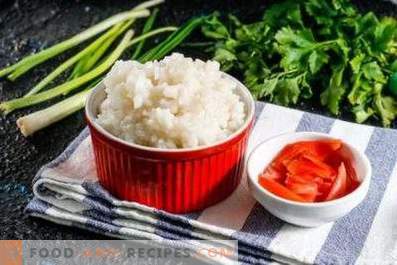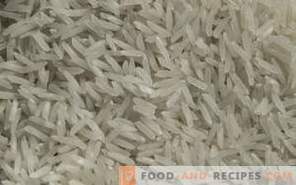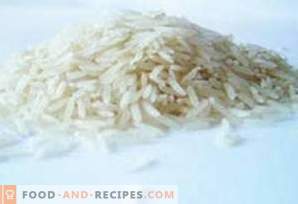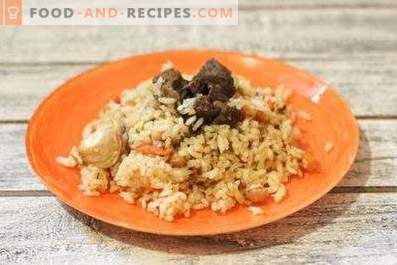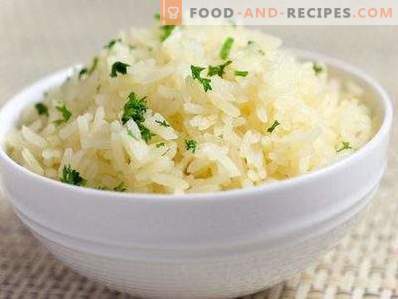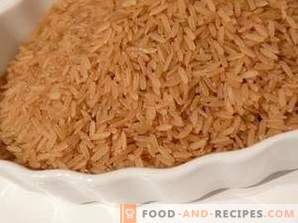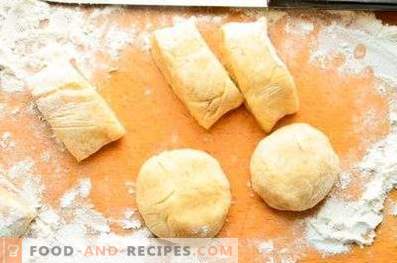
Rice - a cereal rich in trace elements, which (it is very difficult to believe) has not been used for one and a half thousand years! And all because he was forced out by other more popular cereals. Now it's all over, and rice has become popular again. Tons of rice are grown annually on rice plantations.
This grass is not as simple as it seems. There are many types and varieties of rice, and each is special in its own way. For the preparation of the famous rice dish - pilau - not any rice will do. You should know what rice is needed for pilaf, otherwise all efforts will go down the drain and you will not be able to taste this incredibly tasty dish.
What species is rice
The processing methods greatly influence the pic. Even if you treat the same sort of cereal by different methods, you get completely different products in taste and properties. There are 3 main types of rice:
- White, or, as it is also called, polished rice. This type of rice is the most common - it is present in almost every home. Grains may have a shape from round to elongated. White rice is rice that has undergone deep processing, during which it has lost most of the useful elements, but due to this, it is stored and boiled out 2 times faster in 15 minutes.
- Brown, or unpolished, rice is used in cooking much less often, although it contains a large amount of iodine, potassium, calcium, selenium, copper, magnesium, iron, zinc and other valuable biologically active components . In addition, it does not contain gluten, which means that it can be eaten by those who suffer from celiac disease. The small demand for brown rice is explained by the fact that it is more expensive and, compared to other types of rice, is little stored.
- Steamed rice due to the unique technology retains most of its chemical composition, and therefore, in terms of its benefits, it even has the right to compete with brown rice. Grains treated with steaming have a golden hue, which disappears when cooked.
Rice varieties
There are more than 10 thousand varieties of rice, but for the preparation of pilaf most often used are such varieties:
- “Devzira” is the most popular and affordable Uzbek rice, which is specially bred for making pilaf. This rice variety has a sweetish taste and aroma, it can grow in size up to 7 times, during cooking it retains its shape, does not stick together, plus it also perfectly absorbs water, spices and fat. In other words, the best option.
- “Basmati” refers to expensive rice varieties. It is highly regarded in cooking for its unique nut-milky aroma and taste. Basmati is ideal for cooking pilaf. When boiled, its grains are lengthened without sticking to each other. The result is a crumbly pilaf with whole soft grains.
- “Jasmine” - elite rice comes from Thailand. This variety of rice is often used as a substitute for “Basmati”. During cooking, “Jasmine” becomes wet and sticky, but the rice grains do not stick together. In addition, this rice has an extraordinary milky taste and exquisite aroma.
- “Indica” is another common variety of rice that is used to make delicious pilaf. He, like the varieties of rice listed above, has the ability during cooking to retain the shape of the grains and the crispness of the dish. The advantage of this rice is that it absorbs the aroma of spices well.
- “Abrorio” is also an excellent option for making pilaf. Rice "Arborio" does not stick together, swells perfectly and imbues with the smell of pilau ingredients.
Whatever type of rice you prefer, you should always prepare it properly for cooking. First, the rice should be very thoroughly washed to remove excess starch, gluing grains of rice. Then it must be soaked in warm salted water for at least 30 minutes.
Tips on choosing rice for pilaf
To purchase quality rice for pilaf, it is not enough to focus only on the name of the product. You should also pay attention to the following:
- Suitable for pilaf rice has medium-grained or long-grained oblong shape.
- Packed rice should not contain excess litter.
- In high quality croup only whole grains.
- When buying rice, try to figure it out. If this is easy to do, cereal for pilaf is not suitable.
- It is also important that rice grains have a rough, ribbed surface.
- There should be no different GMO impurities in the cereal composition.
- Another important criterion is the absence of an unpleasant odor.
As it turned out, choosing the perfect rice for pilaf is not so difficult. The main thing is to follow all the rules, and then you can cook a delicious dish.
